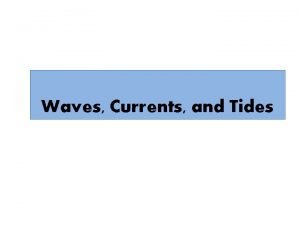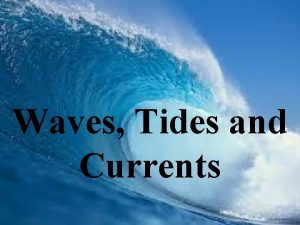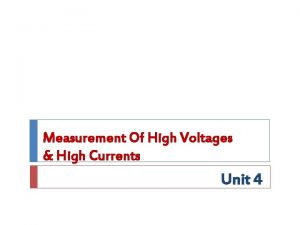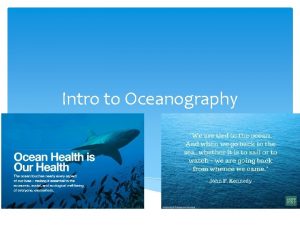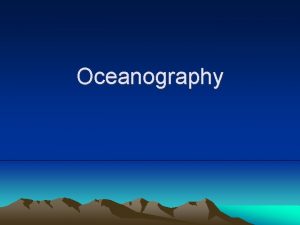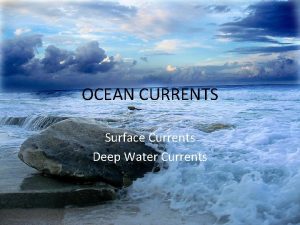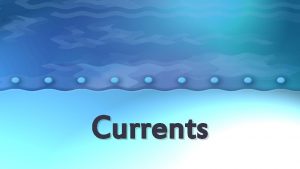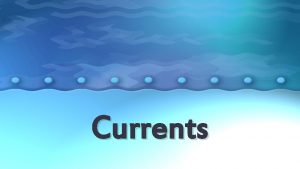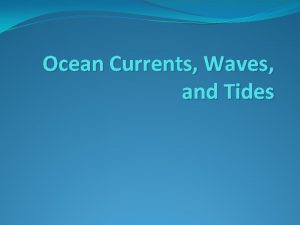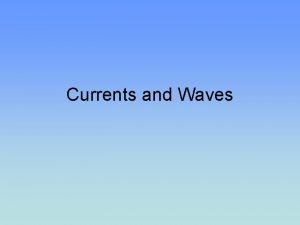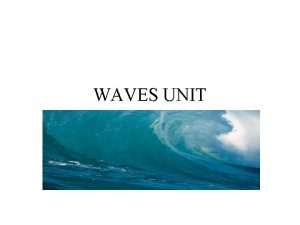Unit 3 Oceanography Section 3 Currents Waves and



















- Slides: 19

Unit 3 – Oceanography Section 3: Currents, Waves, and Tides Earth Science Mr. Margetan

Ocean Currents • Surface Currents – Movement of water on the surface, primarily caused by winds

Ocean Currents • Longshore Currents – Currents which run parallel to the shoreline due to energy released from waves

Ocean Currents • Upwelling Currents – Occur when wind moves seawater at the surface and new water from below replaces it

Critical Thinking #1 • How might upwelling currents be beneficial to life in the ocean? Explain.

Ocean Currents • Deep Currents – Move slowly beneath surface, primarily caused by differing water densities

Critical Thinking #2 • What processes might cause changes in density that form deep ocean currents?

Ocean Currents • Global Conveyor Belt – A connected deep ocean current that circles the entire planet

Waves • Waves – Up and down, circular movement of energy in water – Caused primarily by wind – Also, disturbances in the ocean, earthquakes

Critical Thinking #3 • How are ocean waves similar to seismic waves? How are they different?

Factors Influencing Wave Size • Strength of Wind – Speed wind is blowing • Fetch – Distance wind is blowing • Duration – Length wind is blowing

Parts of a Wave • Crest – Highest point on a wave • Trough – Lowest point on a wave • Wavelength – Horizontal distance from crest to crest • Wave Height – Vertical distance from crest to trough

How do Waves Break? • Waves begin to change shape at a depth ½ its wavelength • Waves break at a depth of 1. 3 x its wave height

Critical Thinking #4 • Considering how waves break, how might the shape of the ocean floor influence the shape of waves?

Types of Breakers • Surging Breakers – Waves roll into the shore, occurs at steep beaches • Plunging Breakers – Waves curl and break, occurs at moderate slope beaches • Spilling Breakers – Waves break far from shore, occurs at gentle slope beaches

Tides • Tides – Daily changes in the level of the ocean surface • 2 high tides and 2 low tides each day – caused by gravitational pull of primarily the moon, but also the sun

High Tides and Low Tides • High (Flood) Tides – Occur on side of Earth facing and opposite the moon, due to both gravity facing and centrifugal force opposite • Low (Ebb) Tides – Occur on sides halfway between the moon

Spring Tides and Neap Tides • Spring Tides = Highest and lowest tides, when moon and sun align • Neap Tides = Small tidal range, when moon and sun are perpendicular

Critical Thinking #5 • Why are spring tides stronger than neap tides? Explain.
 What is deep current
What is deep current Ocean currents waves and tides
Ocean currents waves and tides Study jams waves and currents
Study jams waves and currents Currents waves
Currents waves Compare and contrast p waves and s waves using venn diagram
Compare and contrast p waves and s waves using venn diagram Example of mechanical wave
Example of mechanical wave Example mechanical waves
Example mechanical waves Mechanical and electromagnetic waves similarities
Mechanical and electromagnetic waves similarities Short wave vs long wave radiation
Short wave vs long wave radiation Mechanical waves and electromagnetic waves similarities
Mechanical waves and electromagnetic waves similarities Mechanical and electromagnetic waves similarities
Mechanical and electromagnetic waves similarities Surface waves and body waves
Surface waves and body waves Mechanical wave and electromagnetic wave
Mechanical wave and electromagnetic wave Aimtoknow
Aimtoknow Electromagnetic waves are transverse waves true or false
Electromagnetic waves are transverse waves true or false Characteristics of a longitudinal wave
Characteristics of a longitudinal wave Is echolocation transverse or longitudinal
Is echolocation transverse or longitudinal Mechanical vs electromagnetic
Mechanical vs electromagnetic Is a seismic wave mechanical or electromagnetic
Is a seismic wave mechanical or electromagnetic High ohmic series resistance with microammeter
High ohmic series resistance with microammeter


